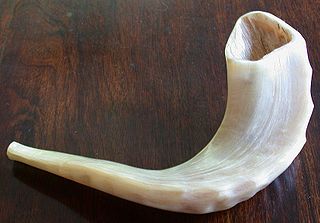
Adar is the sixth month of the civil year and the twelfth month of the religious year on the Hebrew calendar, roughly corresponding to the month of March in the Gregorian calendar. It is a month of 29 days.
This is a list of notable events in the development of Jewish history. All dates are given according to the Common Era, not the Hebrew calendar.

Av is the eleventh month of the civil year and the fifth month of the ecclesiastical year on the Hebrew calendar. It is a month of 30 days, and usually occurs in July–August on the Gregorian calendar.

Tevet is the fourth month of the civil year and the tenth month of the ecclesiastical year on the Hebrew calendar. It follows Kislev and precedes Shevat. It is a month of 29 days. Tevet usually occurs in December–January on the Gregorian calendar. In the Babylonian calendar its name was Araḫ Ṭebētum, the "muddy month".

Marcheshvan, sometimes shortened to Cheshvan, is the second month of the civil year, and the eighth month of the ecclesiastical year on the Hebrew calendar.

Sivan is the ninth month of the civil year and the third month of the religious year on the Hebrew calendar. It is a month of 30 days. Sivan usually falls in May–June on the Gregorian calendar.

Elul is the twelfth month of the civil year and the sixth month of the religious year in the Hebrew calendar. It is a month of 29 days. Elul usually occurs in August–September on the Gregorian calendar.

Jewish history is the history of the Jews, and their nation, religion, and culture, as it developed and interacted with other peoples, religions, and cultures.

Tisha B'Av is an annual fast day in Judaism, on which a number of disasters in Jewish history occurred, primarily the destruction of both Solomon's Temple by the Neo-Babylonian Empire and the Second Temple by the Roman Empire in Jerusalem.

The Hurva Synagogue, also known as Hurvat Rabbi Yehudah he-Hasid, is a synagogue located in the Jewish Quarter of the Old City of Jerusalem.

Tammuz, or Tamuz, is the tenth month of the civil year and the fourth month of the ecclesiastical year on the Hebrew calendar, and the modern Assyrian calendar. It is a month of 29 days, which occurs on the Gregorian calendar around June–July.
The persecution of Jews has been a major event in Jewish history, prompting shifting waves of refugees and the formation of diaspora communities. As early as 605 BCE, Jews who lived in the Neo-Babylonian Empire were persecuted and deported. Antisemitism was also practiced by the governments of many different empires and the adherents of many different religions (Christianity), and it was also widespread in many different regions of the world.

The ancient El Ghriba Synagogue, also known as the Djerba Synagogue, is located on the Tunisian island of Djerba. It is situated in the Jewish village of Hara Seghira, several kilometres southwest of Houmt El Souk, the main town of Djerba.

Belz is a Hasidic dynasty founded in the town of Belz in Western Ukraine, near the Polish border, historically the Crown of the Kingdom of Poland. The group was founded in the early 19th century by Rabbi Shalom Rokeach, also known as the Sar Shalom, and led by his son, Rabbi Yehoshua Rokeach, and grandson, Rabbi Yissachar Dov, and great-grandson, Rabbi Aharon, before the Nazi invasion of Poland in 1939. While Rabbi Aharon managed to escape Europe, together with his brother Rabbi Mordechai Rokeach, most of the Belz Hasidim were murdered in the Holocaust. Rabbi Aharon re-established the Hasidic community in Israel following World War II. At present, Belz has sizable communities in Israel, Western Europe, and the Anglosphere.

Slonim is a Hasidic dynasty originating in the town of Slonim, which is now in Belarus. Today, there are two Slonimer factions. Slonim, based in Jerusalem, and the Slonim community in Bnei Brak. They are two distinct groups today, and have many differences between them.
The history of the Jews and Judaism in the Land of Israel begins in the 2nd millennium BCE, when Israelites emerged as an outgrowth of southern Canaanites, During biblical times, a postulated United Kingdom of Israel existed but then split into two Israelite kingdoms occupying the highland zone: the Kingdom of Israel (Samaria) in the north, and the Kingdom of Judah in the south. The Kingdom of Israel was conquered by the Neo-Assyrian Empire, and the Kingdom of Judah by the Neo-Babylonian Empire. Initially exiled to Babylon, upon the defeat of the Neo-Babylonian Empire by the Achaemenid Empire under Cyrus the Great, many of the Jewish exiles returned to Jerusalem, building the Second Temple.

This article deals in more detail with some of the notable synagogues of Jerusalem that do not have their own page as yet.
Martyrdom in Judaism is one of the main examples of Jews doing a kiddush Hashem, a Hebrew term which means "sanctification of [the] name". An example of this is public self-sacrifice in accordance with Jewish practice and identity, with the possibility of being killed for no other reason than being Jewish. There are specific conditions in Jewish law that deal with the details of self-sacrifice, be it willing or unwilling.

German Rashbilovich Zakharyayev is an Azerbaijani-born businessman, public figure and philanthropist. He is a vice-president of the Russian Jewish Congress and the president of the International Charity Foundation of Mountain Jews STMEGI.














